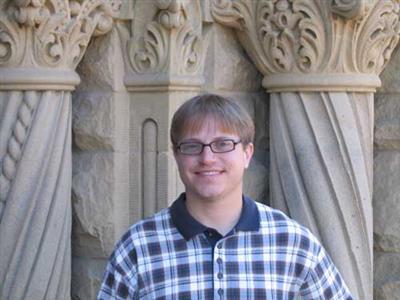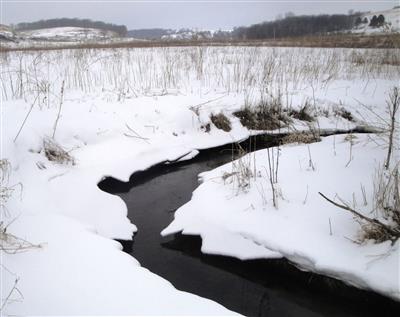September 10, 2014
By Aaron R. Conklin
It was just supposed to be a routine groundwater monitoring exercise on a little stream in Barneveld, Wisconsin. Instead, it opened up an unexpected research project on an unrecognized hydrologic process.
A couple of years ago, Steven Loheide, an associate professor of civil and environmental engineering with the University of Wisconsin-Madison, and his then-undergraduate student Matthew Weber went out to a stream in Barneveld to collect some general data on its flow.

Credit: UW-Madison College of Engineering
They noticed something unusual almost immediately—the stream stage was unusually low compared to the remaining ice that was attached to the stream banks at a height more than double the current water level.
“It made us wonder—what’s going on?” Loheide asked.
Several weeks of observation and data collection gave them the beginnings of an answer. The stream’s dynamics were being heavily influenced by frequent ice formation and ice melt. It turned out that the formation cycle was occurring one out of every four days between December and February, and it was causing the stream depth to increase more than 100 percent as the ice cover slowed down the in-stream water velocity.
‘We weren’t out there to study this,” said Loheide. “This is a process unrecognized in the literature. It’s a big gap. We don’t know the full importance, but we know it’s definitely affecting in-stream hydraulics and potentially inducing hyporheic exchange.”
Loheide is referring to the hypoheic zone, a mixed zone in a stream bed where surface and groundwater mix, creating critical chemical exchanges that have an impact on both the stream itself and the surrounding aquifer by filtering out contaminants and providing habitat for benthic organisms.
According to Weber, who’s now a student in California, it’s possible these exchanges could be significantly altered by the frequent fluctuations in stream stage, and those changes could impact everything from sediment transport to benthic insect populations in spring.
“Because it’s happening in winter, we wouldn’t expect this to have a big impact on nutrient cycling,” said Weber. “But if it’s happening frequently—as it seems to be –the stage fluctuations will have an impact on streambed morphology and potentially affect benthic organisms like overwintering fish eggs and macroinvertebrates in the stream itself.”
The dynamic could also be creating positive impacts. One possibility is that increased winter ice regimes could be backing water up into the landscape, creating a reservoir and making more water available for ecosystems long after the ice is gone.
On larger rivers, this type of ice-formation process creates troublesome ice dams and ice jams that can wreak havoc on docks and shoreline structures. In a small stream like the one in Barneveld, the effect isn’t nearly as easy to see.

Credit: Matthew Weber
“The question we’re pursuing is, how does it affect surface-groundwater connections?” Loheide asked. “We [scientists] haven’t looked at how ice level affects that.”
Having discovered the phenomenon in a single small stream, Loheide and a new graduate student will use funding from the UW Water Resources Institute to see if it occurs—and if so, how often and how it varies–in other geographic areas around the state.
“The new project looks at the bigger picture,” said Weber. “What are the other conditions that allow for this to occur?”
More specifically, beginning in fall, the new student will pore over raw historical data collected by the U.S. Geological Survey using stage and ice regime changes to identify long-term trends. The second stage of the study, which won’t begin until next winter, will involve measuring the ice regimes at five different sites in Wisconsin, looking specifically at the quantity of water exchanged between the stream and the adjacent aquifer. Finally, Loheide and his student will take what they’ve gathered back into the lab and model it. Given that the stream dynamics are tied to the length and severity of winters, which in turn is tied to the discussion on climate change, Loheide’s work takes on an added significance.
“The exciting part of this project is that it’s so new, Loheide said. “This is not like working out the third decimal point of a discovery that’s already been documented. This is an entirely new process.”



